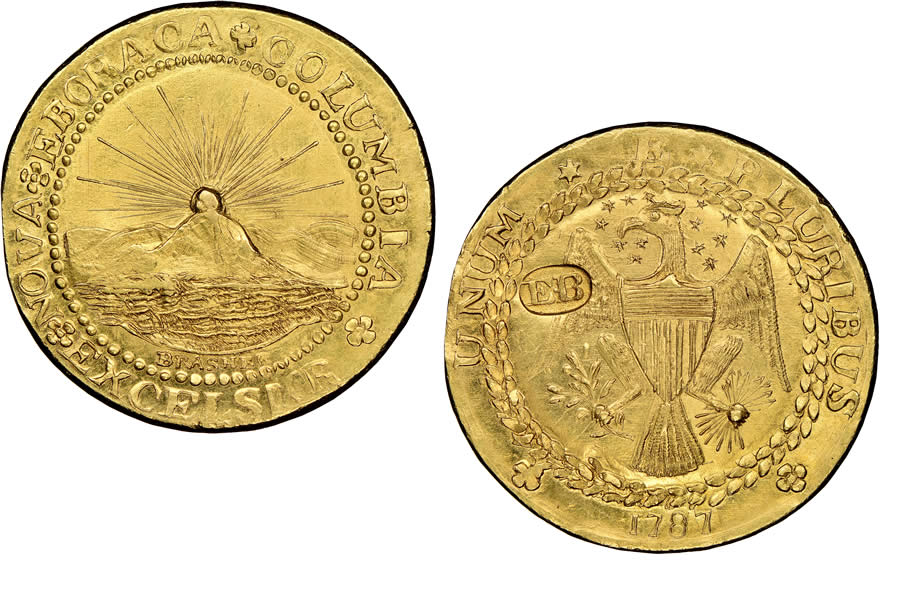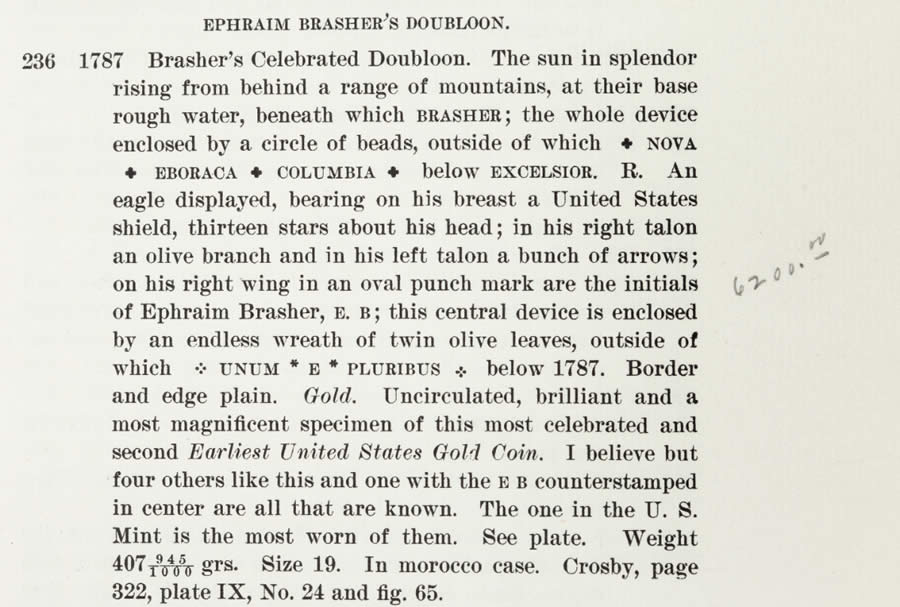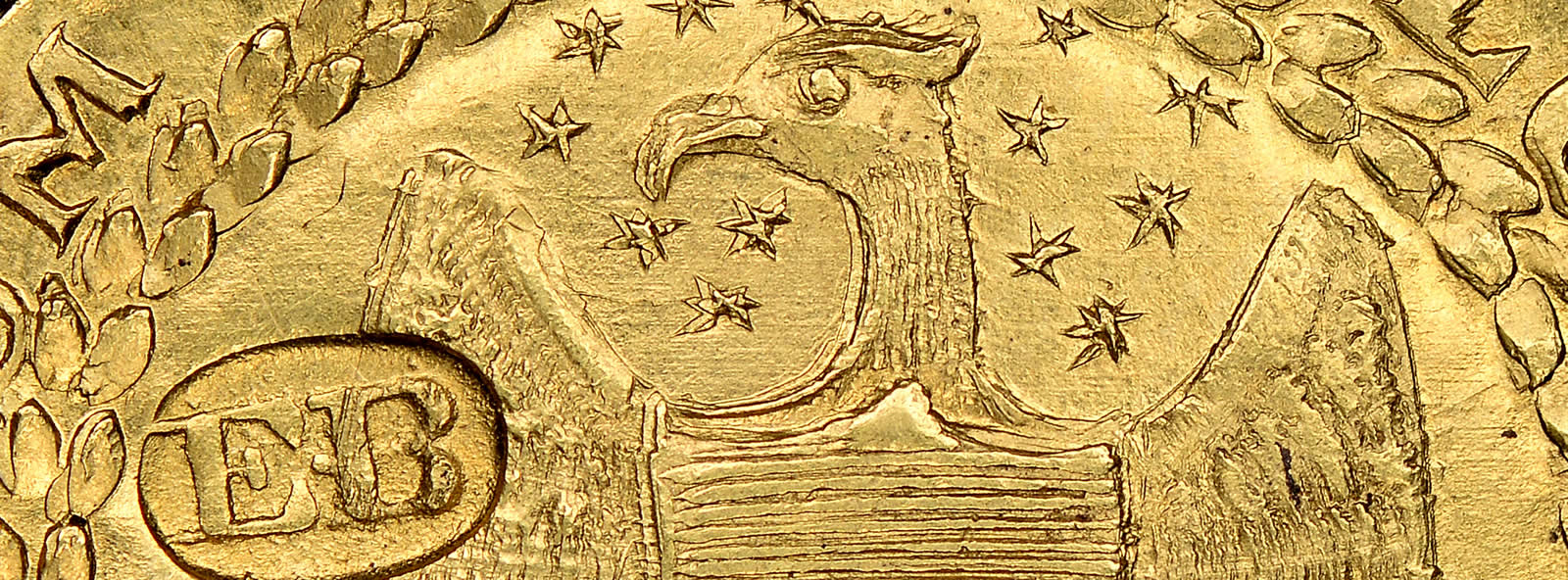PARTRICK 1787 NEW YORK-STYLE BRASHER DOUBLOON IS ONE OF ONLY SEVEN-KNOWN EXAMPLES
By David Stone
The 1787 Brasher doubloon is without a doubt one of the most exciting, valuable, and historically important coins ever produced in the United States.
RARE COINS
EVENT
U.S. COINS SIGNATURE® AUCTION 1326
Florida United Numismatists Show 2021-The Donald G. Partrick Platinum Night Sale of Colonial Rarities
Jan. 20-24, 2021
Online: HA.com/1326a
INQUIRIES
800-USCOINS (872-6467)
Numismatists have recognized the issue as something special since the coins were first discovered in the 1830s. Featured in Hollywood movies and popular detective novels, they have assumed a position in popular culture beyond that of any other coin. Of the seven examples known, two are unavailable to collectors: One is held by the Smithsonian Institution and the other by the American Numismatic Society. This coin’s only auction appearances, in 1907 and 1979, set world-record prices. We are confident that numismatic history will be made for a third time, when the finest example of this iconic issue is offered in Heritage Auctions’ January 2021 “Partrick Platinum! The Donald G. Partrick Sale of Colonial Rarities.”
BRASHER DOUBLOON’S ORIGIN
New York City silversmith Ephraim Brasher produced his Brasher doubloons, and other private coinage, at his shop at 79 Queen Street. Brasher was a prominent man in his time. Like his more famous silversmith contemporary, Paul Revere, he was a patriot of the American Revolution, and he lived next door to President George Washington when New York City served as the nation’s capital, from April 1789 to July 1790. Washington’s residence was at number 3 Cherry Street, in a fashionable Manhattan neighborhood, near the present-day Brooklyn Bridge.
Enlarge

Brasher was a successful silversmith, assayer and private coiner who served in several important municipal positions over the years. After producing his closely related Lima doubloons in 1786 and the popular Nova Eborac coppers in early 1787, Brasher struck his numismatic masterpiece, the New York-style Brasher doubloon, in 1787. The coins featured an adaptation of the New York coat of arms on the obverse and a heraldic eagle, with the legend UNUM E PLURIBUS on the reverse. Brasher punched the reverse with his well-known EB counterstamp, to guarantee the coins were of full weight and value. Although the mintage of the New York-style Brasher doubloon was undoubtedly small, we believe the coins were intended to serve in commerce, possibly to settle large accounts in foreign trade.
NUMISMATIC DISCOVERY
Chief Coiner of the Mint Adam Eckfeldt culled an example of the New York-style Brasher doubloon from a group of gold coins turned in for recoinage at the Philadelphia Mint and placed it in the newly established Mint Cabinet in 1838. It is possible that Baltimore collector Robert Gilmor Jr. discovered an example even earlier, as a March 18, 1840-dated letter from Cambridge, Mass., collector William G. Stearns, to a Dr. Bowditch in England, describes a coin in Gilmor’s collection that can only be a Brasher doubloon:
Enlarge

“There is also a gold coin of New York, of the value of about ten dollars, but I know nothing of its place of coinage or its history. Obverse, the arms of New York. Reverse, the arms of the United States. The only specimen within my knowledge, is in the possession of Mr. Gilmor, of Baltimore. I have not seen the coin, and do not know even its date.”
The letter was reprinted in the July 1840-January 1841 edition of the Numismatic Chronicle and the October 1872 edition of the American Journal of Numismatics. It may be that Gilmor had owned the coin for some time before Stearns mentioned it in print, but where and when he acquired it remains a mystery.
THE STICKNEY-GARRETT-PARTRICK BRASHER DOUBLOON
Although the Smithsonian and Gilmor examples were discovered earlier, the finest-known Partrick Brasher doubloon captured the attention of pioneer coin collector Matthew Stickney shortly afterward. Stickney, a resident of Salem, Mass., started collecting coins sometime around 1820. He was a successful merchant, with a thriving grocery business, and good connections with the Mint and New York bullion and exchange brokers, like Beebee, Ludlow & Co. He had an arrangement with the latter firm to purchase interesting coins that turned up in their coffers, sending money to cover prospective purchases on a regular basis. A careful reading of a previously unpublished letter from this firm (in Stickney’s papers at the Peabody Essex Museum) reveals the source of the Partrick Brasher doubloon:
New York March 16th 1848
M.A. Stickney
Sir,
We received your letter enclosing $25 two weeks since but delayed answering until we would have some coins to send for your selection. We now send a bag contg. [containing] fourteen gold coins with prices marked. You can select what will please you and send the remainder back. We have not at present any silver coins.
Yours Respectfully,
Beebee, Ludlow & Co.
John [Gelston]
Below the text was a scattering of calculations for prices of different groups of coins (probably written by Stickney himself) and a list of 14 mostly foreign gold coins, with prices. However, the first item on the list was an American gold coin with NOVA EBORACA in the legend, priced at $16.
Enlarge

This piece could only be the Brasher doubloon, the sole American colonial gold coin with the words NOVA EBORACA in the legend. Further confirmation comes from the $16 price, which closely matches the intrinsic value of a Brasher doubloon in 1848. Seldom in numismatic history has such an important issue been so inconspicuously introduced.
Stickney formed one of the most important coin collections of the 19th century, acquiring his coins in transactions like this, long before an organized numismatic community of collectors, dealers and numismatic organizations was established in this country. He retained his coins until his death in 1894 and his daughters finally consigned the collection to prominent Philadelphia coin dealer Henry Chapman in 1907. Chapman described the Brasher doubloon in lot 236 of his June 1907 catalog.
The coin realized a staggering $6,200, more than doubling the previous world record for any coin sold at auction. That record would stand for more than two decades.
Ohio industrialist and coin collector James Ellsworth was the buyer of the Brasher doubloon at the Stickney sale. He kept the coin until he sold his entire collection to a partnership of Baltimore collector John Work Garrett and New York coin dealer Wayte Raymond in 1923. Garrett kept the colonial and territorial issues, including the Brasher doubloon, for his collection, and Raymond acquired the U.S. federal issues for stock.
The fabulous Garrett Collection was begun by T. Harrison Garrett in the 1860s. The Garretts were prominent businessmen and chief stockholders in the B. & O. Railroad, of Monopoly board game fame. The elder Garrett formed one of the premier coin collections in the country before his untimely death in a boating accident in 1888. The collection passed to his sons, Robert and John Work Garrett. John Work Garrett eventually bought out his brother’s share of the collection and retained that superb numismatic gathering until his passing in 1942. The collection was donated to Johns Hopkins University after his death.
Enlarge

Several high-profile robberies involving Brasher doubloons took place in the 1960s, and security concerns convinced the university to sell the Garrett Collection in a series of blockbuster auctions through Stack’s and Bowers and Ruddy, beginning in 1976. The Stickney-Garrett specimen of the Brasher doubloon crossed the auction block in lot 607 of the Garrett Collection, Part I (Bowers and Ruddy, 11/1979). Martin Monas, acting as agent for Donald Groves Partrick, purchased the lot for another world record price of $725,000. That record stood for more than 10 years.
New York real estate developer Donald Groves Partrick (1926- 2020) spent five decades building the finest collection of U.S. colonial coins ever assembled. The finest-known 1787 Brasher doubloon has been a part of that famous collection for more than 40 years. To underline the importance of this coin’s upcoming appearance in the Heritage FUN auction, it should be noted that no example of the 1787 Brasher doubloon was publicly offered for a period of 57 years, from 1922 through 1979. All the available examples are currently held in strong hands, making the Heritage offering of this finest-known specimen a truly once-in-a-lifetime opportunity.
 DAVID STONE is a numismatic cataloger at Heritage Auctions who has written for The Numismatist and Coin World.
DAVID STONE is a numismatic cataloger at Heritage Auctions who has written for The Numismatist and Coin World.
This article appears in the Winter 2020-2021 edition of The Intelligent Collector magazine. Click here to subscribe to the print edition.

